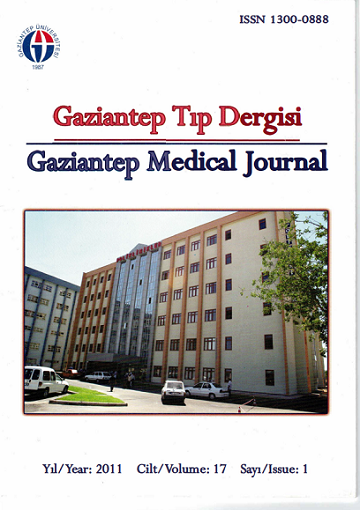Clinical Outcomes of Children Admitted with Admission Diagnosis of Pandemic Influenza
DOI:
https://doi.org/10.58600/eurjther.2011-17-1-741-archKeywords:
Influenza A, H1N1, mortality, risk factor, clinical resultsAbstract
This study was designed to review the risk factors, clinical status and clinical outcomes of patients with an admission diagnosis of pandemic influenza A. Out of 503 patients seen at our hospital’s outpatient Pediatric Unit for flu symptoms between November and December 2009, 42 were admitted. These 42 patients’ risk factors, symptoms, reasons for admission, clinical treatment course and clinical outcomes were analyzed retrospectively. H1N1 was diagnosed using the real-time Reverse Transcriptase-Polymerase Chain Reaction Method (RT-PCR) in nasopharyngeal swabs. Of the 42 patients included in the study, 19 were male (45.2%) and 23 were female (54.8%). The mean age was 8.8 years (patient ages range from six months to 17 years of age). 28 patients were PCR positive (66.6%) and 14 were PCR negative (33.4%). Investigation of risk factors revealed 12 patients with asthma (28.5%), two with cerebral palsy (%4.76), up until one years old children two (%4.76), and one Down Syndrome patient with congenital heart disease (%4.76). No risk factors were identified for 25 patients (59.5%). Admission diagnoses included 15 patients with acute bronchiolitis (35.7%), 12 with acute pharyngitis and general poor health (28.6%), eight with pneumonia (19%), three with acute sinusitis (7%), two with acute gastroenteritis (4.7%) and two with febrile seizures (4.7%). All patients were given oseltamir at admission. The average length of stay was five days (ranging from 2-8 days). One patient required mechanical ventilator and intensive care services. There were no mortalities in the study group. In the event of a new pandemic influenza, patients in the risk groups identified may experience lower risk of mortality if provided with close monitorization and early treatment of potential secondary infections.
Metrics
References
Peiris JS, Tu WW, Yen HL. A novel H1N1 virus causes the first pandemic of the 21st century, Eur J Immunol 2009;39(11):2946-54.
Scalera NM, Mossad SB. The first pandemic of the 21st century: A review of the 2009 pandemic variant influenza A (H1N1) virus. Postgrad Med 2009;121(5):43-7.
Novel Swine-Origin Influenza A (H1N1) Virus Investigation Team, Dawood FS, Jain S, Finelli L, Shaw MW, Lindstrom S, et al. Emergence of a novel swine-origin influenza A (H1N1) virus in humans. N Engl J Med 2009;360(25):2605-15.
Jain R, Goldman RD. Novel influenza A (H1N1). Clinical presentation, diagnosis, and management. Pediatr Emer Care 2009;25:791-6.
Sullivan SJ, Jacobson RM, Dowdle WR, Poland GA. 2009 H1N1 influenza. Mayo Clin Proc 2010;85:64-76.
CDC. Interim Guidance for Clinicians on the Prevention and Treatment of Swin Origin Influenza Virus Infection in Young Children. Centers for Disease Control and Prevention. Available at http://www.cdc.gov/swineflu/childrentreatment.htm. (Erişim tarihi: 30 Nisan 2009).
World Health Organization (WHO). WHO guidelines for pharmacological management of pandemic (H1N1) 2009 influenza and other influenza viruses. Geneva, Switz: World Health Organization; 2009. Available from: http://www.who.int/csr/resources/publications/ swineflu/h1n1- use-antivirals-20090820/en/index.html (Erişim tarihi: 16 Ocak 2010).
Saltoğlu N, Balkan İİ. H1N1: Klinik görünümler. ANKEM Derg 2010;24(Ek 2):196-200.
Larcombe PJ, Moloney SE, Schmidt PA. Pandemic (H1N1) 2009: A clinical spectrum in the general paediatric population. Arch Dis Child 2011;96(1):96-8.
O’Riordan S, Barton M, Yau Y, Read SE, Allen U, Tran D. Risk factors and outcomes among children admitted to hospital with pandemic H1N1 influenza. CMAJ 2010;182:39-44.
Libster R, Bugna J, Coviello S, Hijano DR, Dunaiewsky M, Reynoso N, et al. Pediatric hospitalizations associated with 2009 pandemic influenza A (H1N1) in Argentina. N Engl J Med 2010;362(1):45-55.
Jain S, Kamimoto L, Bramley AM, Schmitz AM, Benoit SR, Louie J, et al. Hospitalized patients with 2009 H1N1 influenza in the United States, April- June 2009. N Engl J Med 2009;361(20):1935-44.
Hasegawa M, Hashimoto K, Morozumi M, Ubukata K, Takahashi T, Inamo Y. Spontaneous pneumomediastinum complicating pneumonia in children infected with the 2009 pandemic influenza A (H1N1) virus. Clin Microbiol Infect 2010;16(2):195-9.
Lyon JB, Remigio C, Milligan T, Deline C. Acute necrotizing encephalopathy in a child with H1N1 influenza infection. Pediatr Radiol 2010;40:200-5.
Koliou M, Hadjiloizou S, Ourani S, Demosthenous A, Hadjidemetriou A. A case of benign acute childhood myositis associated with influenza A (H1N1) virus infection. Clin Microbiol Infect 2010;16(2):193-5.
Satpathy HK, Lindsay M, Kawwass JF. Novel H1N1 virus infection and pregnancy. Postgrad Med 2009;121(6):106-12.
Vaillant L, La Ruche G, Tarantola A, Barboza P; epidemic intelligence team at InVS. Epidemiology of fatal cases associated with pandemic H1N1 influenza 2009. Euro Surveill 2009;14(33). pii=19309. Available from: http://www.eurosurveillance.org/viewarticle.aspx?articleid=193 193.
Pebody RG, McLean E, Zhao H, Cleary P, Bracebridge S, Foster K, et al. Pandemic Influenza A (H1N1) 2009 and mortality in the United Kingdom: risk factors for death, April 2009 to March 2010. Euro Surveill. 2010;15(20). pii: 19571.
United States Centers for Disease Control and Prevention. Recommendations for use of antiviral medications for the management of influenza in children and adolescents for the 2009-2010 season - pediatric supplement for healthcare providers. http://www.cdc.gov/h1n1flu/recommendations_pediatric_supple ment.htm (Erişim tarihi: 14 Aralık 2009).
Hackett S, Hill L, Patel J, et al. Clinical characteristics of paediatric H1N1 admissions in Birmingham, UK. Lancet 2009; 374:605.
Hackett S, Hill L, Patel J, Ratnaraja N, Ifeyinwa A, Farooqi M, et al. Swine-origin influenza virus H1N1, seasonal influenza virus, and critical illness in children. Lancet 2009;374:605-7.
Pandemic (H1N1) 2009-update 81, weekly virological surveillance update. Available from: http://www.who.int/csr/disease/swineflu/laboratory30_ 12_2009/en/index.html. (Erişim tarihi: 05 Ocak 2010).
T.C. Sağlık Bakanlığı. Pandemik (H1N1) 2009 Gribi Klinik Vaka Yönetimi (25 Kasım 2009). http://www.grip.saglik.gov.tr (Erişim tarihi: 18 Ocak 2010).
Centers for Disease Control and Prevention (CDC). H1N1 flu. Updated interim recommendations for the use of antiviral medications in the treatment and prevention of influenza for the 2009-2010 season. Atlanta, GA: Centers for Disease Control and Prevention; 2009. Available from: http://www.cdc.gov/h1n1flu/ recommendations.htm (Erişim tarihi: 16 Ocak 2010).
Downloads
Published
How to Cite
Issue
Section
License
Copyright (c) 2023 European Journal of Therapeutics

This work is licensed under a Creative Commons Attribution-NonCommercial 4.0 International License.
The content of this journal is licensed under a Creative Commons Attribution-NonCommercial 4.0 International License.


















